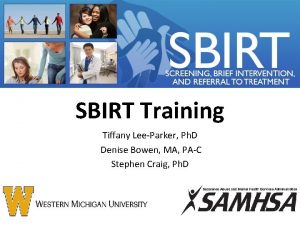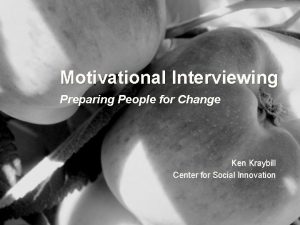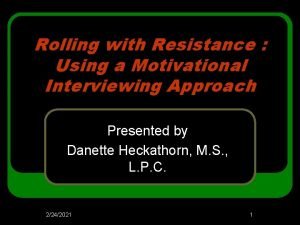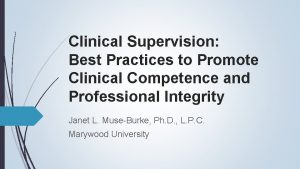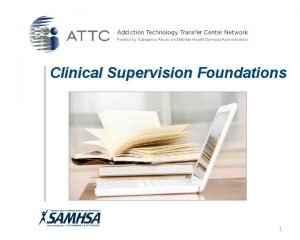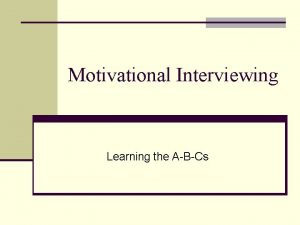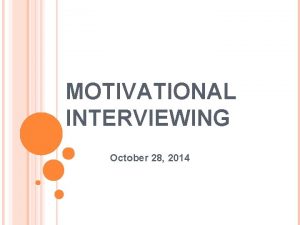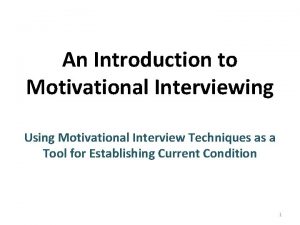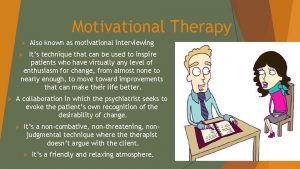MOTIVATIONAL INTERVIEWING in CLINICAL SUPERVISION Ann D Carden



































- Slides: 35

MOTIVATIONAL INTERVIEWING in CLINICAL SUPERVISION Ann D. Carden, Ph. D. Carden. Ann@aol. com © Ann D. Carden, Ph. D. - 2006 1

Guiding Principle #1 Express Empathy © Ann D. Carden, Ph. D. - 2006 2

Self-Regulation Theory © Ann D. Carden, Ph. D. - 2006 3

Intentional change is grounded in awareness of one’s core values and life goals and the gap between those values and goals and one’s present behaviors © Ann D. Carden, Ph. D. - 2006 4

“They say you can lead a horse to water, but you cant’ make him drink…but I say, you can salt the oats. ” Madeline Hunter © Ann D. Carden, Ph. D. - 2006 5

Guiding Principle #2 Develop Discrepancy © Ann D. Carden, Ph. D. - 2006 6

Trans-theoretical Stages of Change Model © Ann D. Carden, Ph. D. - 2006 7

Stages of Change n Precontemplation n Contemplation n Preparation n Action n Maintenance n Termination © Ann D. Carden, Ph. D. - 2006 8

• Resources – internal & external • Risks – internal & external • Readiness ------> intervention © Ann D. Carden, Ph. D. - 2006 9

Guiding Principle #3 Roll with Resistance © Ann D. Carden, Ph. D. - 2006 10

Self-Perception Theory © Ann D. Carden, Ph. D. - 2006 11

Concern Problem Recognition Cog nitiv e ctive Affe REASONS NEED DESIRE Intention COMMITMENT Behavioral Confidence ABILITY © Ann D. Carden, Ph. D. - 2006 12

The Flow of Change Talk MI Desire Ability Reasons Need Commitment Change © Ann D. Carden, Ph. D. - 2006 13

Guiding Principle #4 Support Self-efficacy © Ann D. Carden, Ph. D. - 2006 14

Intentional Change is a process, not an event! © Ann D. Carden, Ph. D. - 2006 15

Intentional change is more likely to occur when goals are Ø Ø Ø Small Important to the goal-setter Specific/Concrete/Measurable Present-focused Realistic/Practical A presence rather than an absence © Ann D. Carden, Ph. D. - 2006 16

Three Phases in the Intentional Change Process © Ann D. Carden, Ph. D. - 2006 17

Common Barriers to Self. Enhancing Intentional Change n n n n n Cluelessness Minimization Projection of responsibility Immediate gratification Fear of failure Skills deficits Information gaps Fear of the unknown Lack of social / material supports Competing stressors © Ann D. Carden, Ph. D. - 2006 18

“Given a choice between changing and proving that it is not necessary, most people get busy with the proof. ” © Ann D. Carden, Ph. D. - 2006 John Galbraith 19

It’s not so much that we’re afraid of change or so in love with the old ways, but it’s that place in between that we fear … It’s like being between trapezes … It’s Linus when his blanket is in the drier. There’s nothing to hold on to. Marilyn Ferguson © Ann D. Carden, Ph. D. - 2006 20

Ambivalence “People often get stuck, not because they fail to appreciate the down side of their situation, but because they feel at least two ways about it. ” Miller & Rollnick © Ann D. Carden, Ph. D. - 2006 21

Ambivalence approach-approach-avoidance-avoidance double approach avoidance © Ann D. Carden, Ph. D. - 2006 22

Motivation When the balance tips away from resistance and toward commitment Never completely free of ambivalence and resistance Requires on-going “buy in” at the level of thinking feelings actions © Ann D. Carden, Ph. D. - 2006 23

Six Supervisor Guidelines 1. Adhere to the MI Guiding Principles 2. Avoid Traps / Roadblocks to progress 3. Teach / model the Philosophical Foundations of MI 4. Maintain a clinical focus 5. Adapt to the Supervisee’s context 6. Assist supervisees to become proficient in MI clinical skills © Ann D. Carden, Ph. D. - 2006 24

Ongoing assessment of client’s: § § © Ann D. Carden, Ph. D. - 2006 stages resources risks readiness 25

Ongoing assessment of supervisee’s: § § alliance with client MI consistent interventions goals for client beliefs about outcomes © Ann D. Carden, Ph. D. - 2006 26

Supervisory Responsibility “Above all do no harm” © Ann D. Carden, Ph. D. - 2006 27

Six Supervisor Guidelines 1. Adhere to the MI Guiding Principles 2. Avoid Traps / Roadblocks to progress 3. Teach / model the Philosophical Foundations of MI 4. Maintain a clinical focus 5. Adapt to the Supervisee’s context 6. Assist supervisees to become proficient in MI clinical skills © Ann D. Carden, Ph. D. - 2006 28

Cultural Diversity n n n n n Age Socio-economic status Gender / sexual orientation Ethnicity / race Geographic location Religion Educational level and type Life roles Disability / diagnosis © Ann D. Carden, Ph. D. - 2006 29

Cultural effects …. n n n n n Values Perspective Meanings Relationships Independence Current focus / life task Time orientation / pacing Communication and learning style Client-counselor alliance © Ann D. Carden, Ph. D. - 2006 30

Client-Related Stressors of Direct Service Providers n n n n Client resistance / supervisee’s unrealistic expectations of client change Boundary issues/ethical dilemmas Client suicide/attempts Client anger/hostility Premature termination Client violence toward others Client death © Ann D. Carden, Ph. D. - 2006 31

Job-Related Stressors of Direct Service Providers n n n n Isolation / insufficient supports Productivity pressures / time crunches Paperwork, paperwork Organizational politics Low pay Self-doubt Perfectionism / compulsive responsibility Limited training opportunities © Ann D. Carden, Ph. D. - 2006 32

Moving Toward Melt-down/Freeze-up n n n n Increased absenteeism Over-reacting Physical complaints Chronic exhaustion Low self-confidence Depression / Anxiety Procrastination Boundary violations Cynical attitude about job / clients Social withdrawal Hostility Us-them mentality Disorganized thinking / behavior © Ann D. Carden, Ph. D. - 2006 33

Six Supervisor Guidelines 1. Adhere to the MI Guiding Principles 2. Avoid Traps / Roadblocks to progress 3. Teach / model the Philosophical Foundations of MI 4. Maintain a clinical focus 5. Adapt to the Supervisee’s context 6. Assist supervisees to become proficient in MI clinical skills © Ann D. Carden, Ph. D. - 2006 34

Consolidate Counter Elicit/Explore Principles Opening MI Spirit Strategies Traps Change Talk Sustain Talk MI Core Skills © Ann D. Carden, Ph. D. - 2006 Commitment 35
 Motivational interviewing case management
Motivational interviewing case management Sbirt faith and spirituality
Sbirt faith and spirituality Contoh motivational interviewing
Contoh motivational interviewing Mi readiness ruler
Mi readiness ruler Agenda mapping bubble sheet
Agenda mapping bubble sheet Motivational interviewing dears
Motivational interviewing dears Darn cat motivational interviewing
Darn cat motivational interviewing Motivational interviewing
Motivational interviewing Darn cat motivational interviewing
Darn cat motivational interviewing Dears motivational interviewing
Dears motivational interviewing Motivational interviewing
Motivational interviewing Desire ability reason need
Desire ability reason need Jeremy wampler
Jeremy wampler Motivational interviewing
Motivational interviewing Ken kraybill
Ken kraybill Motivational interviewing
Motivational interviewing Motivational interviewing schizophrenia
Motivational interviewing schizophrenia Dares motivational interviewing
Dares motivational interviewing Darn cat change talk
Darn cat change talk Nimi singh
Nimi singh Motivational interviewing wiki
Motivational interviewing wiki Motivational interviewing roll with resistance
Motivational interviewing roll with resistance Agreement with a twist motivational interviewing
Agreement with a twist motivational interviewing Shifting focus motivational interviewing
Shifting focus motivational interviewing Darn cat motivational interviewing
Darn cat motivational interviewing Motivational interviewing basics
Motivational interviewing basics Stages of change social work
Stages of change social work Goals of clinical supervision
Goals of clinical supervision Stages of clinical supervision
Stages of clinical supervision Clinical supervision questions
Clinical supervision questions Best practices in clinical supervision
Best practices in clinical supervision Clinical supervision questions
Clinical supervision questions Tall tale story
Tall tale story Carol ann duffy anne hathaway analysis
Carol ann duffy anne hathaway analysis Ten traps of interviewing
Ten traps of interviewing The craft of interviewing in realist evaluation
The craft of interviewing in realist evaluation








